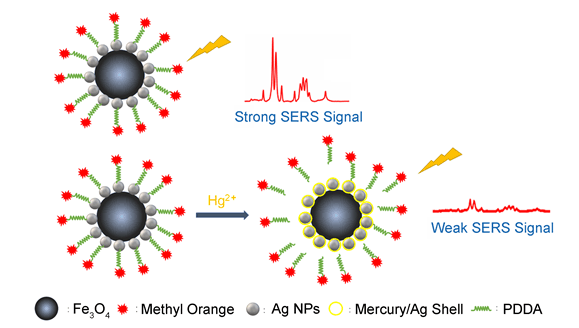摘要/Abstract

近年来,汞作为一种重要的污染物引起了人们的广泛关注.迄今为止,基于表面增强拉曼光谱(Surface-enhanced Raman scattering,SERS)的Hg2+检测方法因其在不同的检测方法中具有高灵敏度而备受关注.基于“turn-off”机制,我们合成出一种磁性Fe3O4@Ag(FA)纳米材料用于Hg2+的SERS检测.磁等离子体共振纳米颗粒结合了磁共振和等离子体共振特性,可用于高灵敏度和高选择性的汞离子的SERS检测.通过修饰带正电的聚二烯丙基二甲基氯化铵(PDADMAC,PolyDADMAC,PDDA)层,Fe3O4@Ag表面吸附上带负电的甲基橙探针分子,在Hg2+存在的情况下,可以观察到SERS信号显著降低.由于Hg2+与Ag纳米颗粒会快速反应并在Ag纳米颗粒表面形成一层汞齐,从而影响了Ag纳米颗粒的表面等离子体共振(Surface Plasmon Resonance,SPR)性能,导致电磁场强度的减弱;同时,这样也会导致Ag纳米颗粒的表面Zeta电位的降低,并且影响拉曼探针分子在其表面的吸附,从而进一步导致SERS信号的降低.因此,在含有Hg2+的情况下,SERS强度的降低主要归因于Hg2+与AgNPs的相互作用.通过我们的实验可以证明,基于“turn-off”机制检测Hg2+的方法的检测限可以低至10-10 mol/L.本实验设计的SERS纳米传感器可用于快速检测环境中Hg2+,为构建重金属离子SERS纳米传感器提供了巨大的潜力.
关键词: 表面增强拉曼光谱, 汞离子(II), 磁性纳米材料, 快速检测, 银纳米粒子
Mercury is an important pollutant, which has attracted wide attention in recent years. Up to now, based on surface enhanced raman spectroscopy (SERS) strategy for detection of Hg2+ is very attractive due to its high sensitivity among various detection methods. Based on the "turn-off" mechanism, we synthesized a magnetic Fe3O4@Ag nanomaterial for SERS detection of Hg2+. The magnetic-plasma resonance nanoparticles, which combine magnetic and plasma resonance properties, can be used for SERS detection of mercury ions with high sensitivity and selectivity. Firstly, the magnetic nanoparticles were prepared by solvothermal reaction, and silver nanoparticles were coated on the surface of magnetic nanoparticles after modification of amino groups. By modifying the positively charged PDADMAC, polyDADMAC (PDDA) layer, the negatively charged methyl orange probe molecule is adsorbed on the surface of Fe3O4@Ag, and in the presence of Hg2+, a significant decrease in SERS signal can be observed. Due to the short-time reaction of Hg2+ and Ag nanoparticles, an amalgam is formed on the surface of the Ag particles, which affects the surface plasmon resonance (SPR) characteristics of the Ag nanoparticles, resulting in enhanced attenuation of the electromagnetic field. And the short-time reaction of Hg2+ and Ag nanoparticles also leads to a decrease in the surface zeta potential of the Ag nanoparticles and affects the adsorption of the Raman probe molecules on the surface, resulting in a decrease in the SERS signal. Therefore, the decrease of SERS intensity in the presence of Hg2+ is mainly attributed to the interaction between Hg2+ and Ag nanoparticles. Through our experiments, it can be proved that the detection limit of the method based on "turn-off" mechanism for detecting Hg2+ ions can be as low as 10-10 mol/L. In addition, this method also shows high selectivity for divalent mercury ions. The SERS nanosensor designed in this experiment can be used to detect the specificity and ultra-sensitivity of Hg2+ in the environment, and it also provides great potential for the construction of SERS nanosensor for heavy metal ions.
Key words: surface enhanced Raman spectroscopy (SERS), mercury(II) ion, magnetic nanomaterial, rapid detection, silver nanoparticle
PDF全文下载地址:
点我下载PDF
